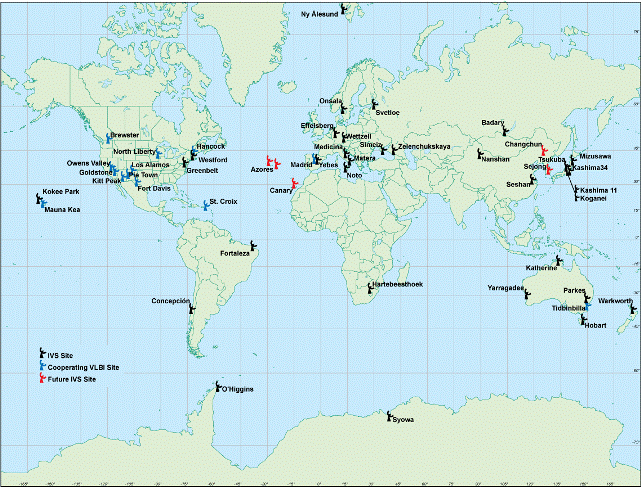VLBI Global Observing System (VGOS)
WEBSITE:
To improve VLBI data to meet increasingly demanding requirements, an end-to-end redesign called the VLBI Global Observing System (VGOS, formerly VLBI2010) is in progress. The key concepts are a broadband signal acquisition chain (2-14 GHz) with digital electronics and fast, small antennas. By placing up to four carefully chosen RF bands in the 2–14 GHz range, Radio Frequency Interference (RFI) should be ameliorated and the requisite observation precision achieved. Fast antennas will provide many more observations. More observations support higher temporal and spatial resolution in estimating the effect of the troposphere at each station. Simulations show tropospheric effects as the largest noise source. High recording bandwidths are required to achieve the necessary sensitivity.
VGOS is being developed to be minimally staffed, remotely controllable, broadband, RFI avoiding, fully digital, fast slewing, and capable of producing VLBI delays with precision of 4 picoseconds (in 4 picoseconds light travels 1 millimeter.) The system is designed to observe continuously.
NASA’s contribution to VGOS, which is managed under the auspices of the Space Geodesy Project in NASA GSFC Code 61A, includes the construction of a 12-m antenna at the Goddard Geophysical and Astronomical Observatory (GGAO) in Greenbelt, Maryland, support for the development of the VGOS antenna at Kokee Park Geophysical Observatory (Hawaii) provided by the U.S. Navy, the construction of a 12-m antenna at the McDonald Observatory (Texas), and the installation of a 12-m VGOS antenna in Tahiti in cooperation with France.
The International VLBI Service for Geodesy and Astrometry (IVS) anticipates a gradual introduction of VGOS systems into the new broadband network as they become available. A number of new and existing telescopes already have accomplished successul VGOS observations: GGAO, Westford, Kokee Park (USA); Ishioka (Japan); Wettzell (Germany); and Yebes (Spain). Several new telescopes are working on the installation of a VGOS signal chain of their new telescopes; these include the Onsala Twin Telescopes (Sweden), the Spanish/Portuguese RAEGE telescope at Santa Maria (Azores, Portugal), and the AuScope antennas at Hobart, Katherine, and Yarragadee (Austrailia). Other sites are in an advanced stage of their telescope construction; e.g., Hartebeesthoek (South Africa); Ny-Alesund (Spitsbergen, Norway), Sheshan (China), and Metsahovi (Finland).

